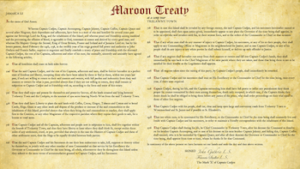
On this date in 1738, escaped African slaves and British settlers in Central America agreed to a conflict truce.
The articles of pacification from the English with the “Maroons” of Trelawny Town, Jamaica, occurred on this date. The Maroons were escaped African slaves with communities in North, Central, and South America. The term Maroon derives from the Spanish word Cimarron. This word was first put on runaway cattle before it came to signify escaped African slaves. The first known Maroon was a slave who escaped from a boat in 1502.
His experience of gaining freedom created a constant surge of others across the Americas who ran away from their captors. These Maroons joined together, forming communities that served as stations for raids on white settlements. Their communities were generally found in remote areas protected by mountains, swamps, or jungles, and often, Maroons joined local Native Central Americans using their methods. Palisades often guarded locations and had well-constructed defenses, such as disguised paths and false routes that led to quicksand and booby traps. Various Spanish and Portuguese terms, including palenques, quilombos, cumbes, ladeires, and mambises, are called maroon communities.
Before 1700, men born in Africa generally led the Maroon population; many claimed they had been Kings in their homeland. After 1700, Maroon leaders were often Creoles familiar with the ways of Whites and with African methods. The leader of the Maroon community in Jamaica was Captain Cudjoe (Kojo). During the 18th century, the Maroons became more powerful and settled in, among other places, the mountains of Jamaica. Carving out a significant area of influence, their threat to the system of slavery was clear; hence, the white planters signed a treaty with the Maroons in 1738. This treaty was an unlikely concession during the eighteenth century, given the dominance of the British class across the Caribbean. The treaty did not exclusively serve the white interest. Article three of the treaty stated that the Maroons were given 1,500 acres of Crown land.
Article eight of the treaty stated: “that if any white man shall do any manner of injury to Cudjoe, his successors or any of his or their people shall apply to any commanding officer or magistrate in the neighborhood for justice.” This showed some equity under the law between the Maroons and White plantation owners. In brief, the British were willing to divide themselves equally among the Maroons. In general, the Articles of Pacification also attempted to limit Maroon's attacks against the system of slavery. Article thirteen required that the Maroons continue to help clear roads from Trelawny Town to Westmoreland and, if possible, from St. James to St. Elizabeth. This was biased because, as free men, the Maroons were not required to labor for the planters, showing a White view that the Maroons were inferior to them.
Another bias in the treaty includes article fourteen, which affirms that two White men shall live with the Maroons “to maintain a friendly correspondence with the inhabitants of this island.” This was to encourage a friendly relationship between the two but gave Whites first-hand knowledge of the state of affairs in the Maroon community. Most importantly, the treaty also required the Maroons to act as a police force for the planters, returning future runaways to the plantations and drafting them to fight against future rebellions.
This treaty recognized the Maroons and their needs and revealed that the British feared their capabilities and ever-rising power.